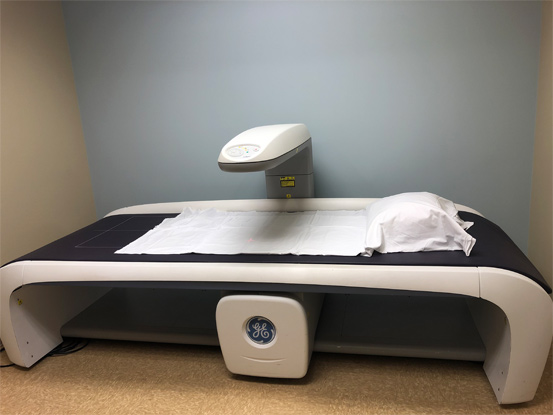Osteoporosis and Fracture Prevention
Osteoporosis is a condition characterized by weakening of bones due to loss of bone density and mass. It is a progressive condition that can cause bones to fracture under mild stress. Osteoporosis commonly occurs in women over the age of 50 and is influenced by certain genetic and environmental factors.
Throughout life bone is both laid down (built) and resorbed (removed) in a process called bone metabolism. This is a normal part of life. As we age more bone is resorbed than build and in patients with osteoporosis the removal process is much greater than the building process.
Some factors which can contribute to osteoporosis are:
- Aging
- Excessive thyroid hormone
- Smoking and alcohol
- Heredity
- Low calcium in diet or reduced calcium absorption by the body
- Low levels of estrogen after menopause
DEXA (Dual-energy X-ray Absorptiometry) scan
To evaluate your bone strength, we will order a bone density test called a Dual-energy X-ray Absorptiometry scan (DEXA scan). The test is painless and takes about 10 minutes to perform. Your bone strength is represented by a T-score value. This compares your bone density to that of a healthy 30 year old adult. A T-score between -1 and -2.5 indicates osteopenia while a T-score below -2.5 indicates osteoporosis. The lower the value of the T-score the greater are the chances of fracture.
 DEXA scan machine at Brandywine Hospital
DEXA scan machine at Brandywine HospitalFollow up scans are recommended. If your initial scan is normal you should have a second scan in 5 years to follow up. If your initial scan shows evidence of osteopenia or osteoporosis we need to discuss the risks and benefits of treatment. Either way a follow up scan is indicated in 2 years to look for a further decrease in density or to follow the effectiveness of treatment.
To strengthen bone, weight bearing exercises are recommended. These exercises stimulate your body to produce more bone. Bone strength is also increased when muscles pull on bone during exercise. Being physically fit also improves your flexibility and reduces your risk of falling. Walking, jogging, climbing stairs, aerobics and dancing are beneficial for improving bone strength, however weight bearing resistance exercise has been shown to be most effective in maintaining bone density. Click this link to get at home resistance exercises to help maintain bone density through the hips.
Calcium Supplementation
Supplementing your diet with adequate amounts of calcium is also important. When calcium stores are reduced, your body draws calcium out of your bones to carry out its processes. This can be avoided by intake of calcium. Good sources of calcium include dairy products, sardines, soy and certain vegetables. Recommended calcium supplementation should not exceed 1200mg per day.
Vitamin D
Vitamin D plays an important role in maintaining normal bone metabolism. Deficiency of vitamin D is very common and we will test your Vitamin D level in the work up of osteoporosis. Recommended supplementation of Vitamin D to your diet is 2000 units of Vitamin D3 every day. In patients with very low levels, large doses are often prescribed until normal levels are reached.
Other lifestyle changes include:
- Reducing alcohol intake
- Avoiding smoking
- Avoiding cola drinks
Prescription Medications
In certain patients, prescription medication may be appropriate. There are two broad categories of medications:
- Medications which prevent loss of bone (more commonly prescribed)
- Medications which build bone (less commonly prescribed)
Medications which prevent loss of bone
These medications are the most commonly prescribed medications for the treatment of osteoporosis.
- Bisphosphonates - Commonly used medications such as Fosamax (Alendronate), Boniva (Ibandronate), Reclast (Zolendronate). Different formulations come in both pill and injection form and are the most commonly prescribed medications to prevent further bone loss. These medications work by incorporating into your bone and work to inhibit the loss of bone as you age. These medications have two important side effects.
- Atypical femur fracture - Paradoxically, taking these medications for more than 5 years can actually lead to a stress fracture in the femur. While this is rare, this is real. Current recommendations state that you should not be on a bisphosphonate for more than 5 years. If you have thigh pain after taking these medications for several years, you need an XR to detect whether there is a stress fracture forming.
- Osteonecrosis of the jaw - These medications alter bony resorption throughout your body which is a normal process. This rare complication most often occurs after a dental extraction. If you are on one of these medications good dental hygiene is important. If you are going to have a dental extraction and are on one of these medications you must tell your dentist More information can be found here
- Prolia (Denosumab) - Prolia is a newer medication and is a type of medication called a monoclonal antibody. It is injected every 6 months and inhibits the conversion of mature bone resorbing cells. It is often used in those who cannot tolerate bisphosphonates or those who have been on a bisphosphonate for 5 years.
- Evista (Raloxifene) - Evista is a Estrogen receptor modulator which interacts with estrogen receptors. It is used in post-menopausal women for the treatment of osteoporosis and is a pill taken daily. This can also be used to reduce the risk of breast cancer in certain women.
Medications which build bone
These medications are approved for patients with a diagnosis of osteoporosis.
- Forteo (Teriparatide), Tymlos (Abaloparatide)- These medications are both forms of parathyroid hormone, a naturally occurring hormone. Interestingly, their effects depend on the length, dose and schedule of administration. When given intermittently the anabolic effects predominate. Both are injected daily in either the thigh or abdomen and are used for 24 months. These medications are FDA approved for postmenopausal women with osteoporosis and a high risk of fracture. They are also approved for men and women with glucocorticoid induced osteoporosis. Common side effects include joint pain, pain in general, nausea, and dizziness. In rats there was a slightly increased risk of a rare form of bone cancer called osteosarcoma. The clinical relevance of is unknown but theoretically exists though unreported as of now.
- Evenity (Romosozumab)- This is a new medication and is classified as a monoclonal antibody. The drugs target is a molecule called sclerostin. Evenity inhibits the action of sclerostin and leads to both bone formation and decreased bone resorption. It is FDA approved for postmenopausal women with osteoporosis and a high risk of fracture. It is given as a monthly injection in the office for a total of 12 months. After a 12-month course, patients should switch to a bisphosphonate. Common side effects include joint pain, swelling, weakness and a headache. More serious side effects include atypical femur fracture and osteonecrosis of the jaw. Finally, Evenity should not be used in patients who have had a heart attack or stroke in the last year. There is a slightly increased risk of having a heart attack or stroke while taking Evenity.
Bottom Line
Osteoporosis is a serious condition which can lead to fragility fractures. While a wrist fracture may be a mere inconvenience a hip fracture can be a life-threatening condition. Maintenance of bone density is important as you age. If you have any questions about the above treatments or how to prevent or treat a fracture we would be happy to discuss with you.
Important Links and Further Reading








